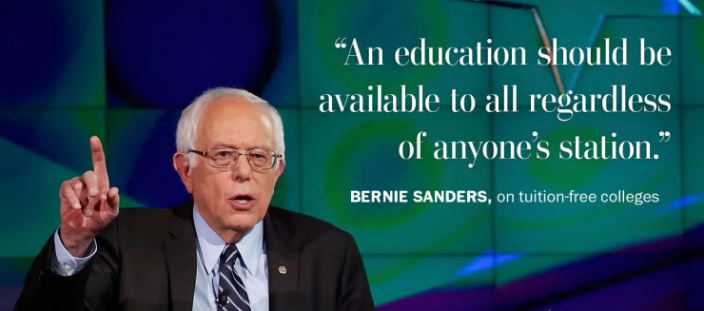Free College for All
Senator Bernie Sanders in his 2016 run for the Democratic nomination for Presidency had included free public colleges as part of his goals if he became president. Since then, the idea of free public colleges has taken hold within the Democratic Party, with multiple candidates for the Democratic nomination this year announcing that they are for free public colleges. The State of New York has also announced plans to make public colleges in that state free for its residents as well. Here, I will go over the pros and cons of free public colleges and explain why I think that although it would help a lot of students attain a good college education and free them off of college debt, it might not be the best policy in the long run.

First, I will talk about the pros of free colleges. There are three good reasons for free public colleges. First, tuition free colleges will help deal with the student debt epidemic in this country. In the US, we have over $1.5 billion in student debt and it has been rising rapidly in the last few decades. This means that students who are graduating from college are already under large amounts of debt, even before they can start their career and start earning to pay off their debts. Unlike many other kinds of debt, student debt does not go away when a person declares bankruptcy, which means that the debt will stick with the students for the rest of their lives until they pay it off. This leads to smart kids not being able to go to college and get a college education due to the high cost. For people who go into debt to go through college, they might be forced to pursue careers they do not like and forgo other spending to pay off their debts. This means that they will be unhappy and under a lot of stress and because they will not be spending much, for example, buying houses or starting a family, because of debt, this is ultimately bad for the country’s GDP.
Secondly, the US had tuition-free colleges in the past. The last generations benefited from free or cheap college tuition under the GI bill for example, for World War II veterans. This was one of the biggest contributors to the economic prosperity for the US in the second half of the 20th century. Our dominance in technology and other sectors is largely because of a strong college education system which has been able to train many great scientists and engineers. Providing free colleges to today’s students will allow us to develop the next generation of scientists and entrepreneurs. The administrative costs within colleges and their tuition have gone up exponentially in the last few decades. However, it does not seem that the quality of education has gone up substantially as the costs rose. If colleges are able to cut their costs, free tuition might be possible with help from the government.
Finally, everyone in the US deserves to have access to a college education if they want, regardless of their economic, social or cultural background. In the current job market, it is becoming increasing difficult to find well-paying jobs without a college degree. Will automation and artificial intelligence becoming more and more important, knowledge of programming and advanced coding will become more and more sought after, while many jobs will be automated away. Because a college education is becoming more of a necessity than an option, it would make sense for the government to step in and help out. This will also help reduce the income inequality in the country because more people will have access to a college education, and have a better chance of having a prosperous life and career.
Now I will describe three cons of tuition-free colleges. First, tuition free colleges will still be expensive. Tuition is only one of the costs of going to college. There are usually also fairly high living expenses for room and board, textbooks, etc. While removing tuitions for state schools will definitely make colleges less expensive, it is unclear whether it will actually help students from poor socioeconomic backgrounds because the cost of college attendance will remain prohibitively high. This will mean that students might still need to get into debt to go to college. Free tuition does not mean debt-free college. This means that free tuition might not be enough, governments will have to pay free room and board to students as well, which will be too expensive. This makes the alternative – cutting administrative costs within colleges more attractive, because it will cause the same outcome.
Secondly, it will be unfair for taxpayers who never go to college to fund the college education of students who do decide to go to college. Free tuition will mean that governments will have to spend more on subsidizing tuitions. This will mean that less money will be left over for other things like childcare, healthcare, defense, etc. This will probably also mean that there will be higher taxes set on everyone to pay for the tuitions. On top of that, many people decide never to go to colleges anyway and instead pursue vocational training or on the job training. It does not make sense to punish these people who decided never to go to college. Free college is not actually free because the government, and the rest of the people will have to pay for it in the form of higher taxes. Instead, it might make more sense for the government to encourage alternatives to a college education, such as vocational training, or encouraging companies to hire more high school graduates. Even if college graduates earn more money, it will take a long time for the government to earn enough tax out of them, which means that local government will be in large debts in the short run. Earlier in this paper, we discussed on college debt reduce spending and is bad for the economy. Higher taxes and government debt are likely to have an even worse impact on the economy at large.
Finally, it is unclear how many students will actually take advantage of free colleges and their compositions and their graduation rates. In terms of composition, it is likely that children from rich households who were going to go to college anyway, and have it paid for by their parents, will continue to go to college anyway and do so for free. In this way, this government subsidy which is aimed at reducing inequality, will actually increase inequality by giving more money to the rich. In terms of graduation rates, it is likely that many students will start their programs and not complete it. This means that they will be using up taxpayer dollars while not actually benefiting from a college degree. Students who were not very interested in colleges anyway might go to college if it is free. This is an inefficient use of resources. We need to make sure that only the best students who really want to go to college are the ones who are encouraged to go, given that resources and seats are limited. We know that community colleges, which tend to be mostly free, or at least much cheaper, have high dropout rates. It is possible that free colleges will have high dropout rates as well.
The expense of a college education today has created a gap of accessibility to what should be a basic human right. It is going to be very important for the government to help reduce the cost of college by setting more standards on cutting administrative, athletic, etc. costs that do not add value to the quality of education, but just help colleges have a better ranking. It will also be important to help out graduates with their student debt. However, I do not think free tuition is the best way to cut the cost of tuition. It will simply transfer the student debt to government debt, instead of actually dealing with the problem of rising tuition in this country.


svides • May 22, 2019 at 8:52 am
I think it is a good idea of having a free collage for all. Some of the people do not really go to collage because of the financial issues. it has been a problem for society that collage is really expensive and many people cannot effort to pay it off. If we have free collage or education many people will still in school and get their education.